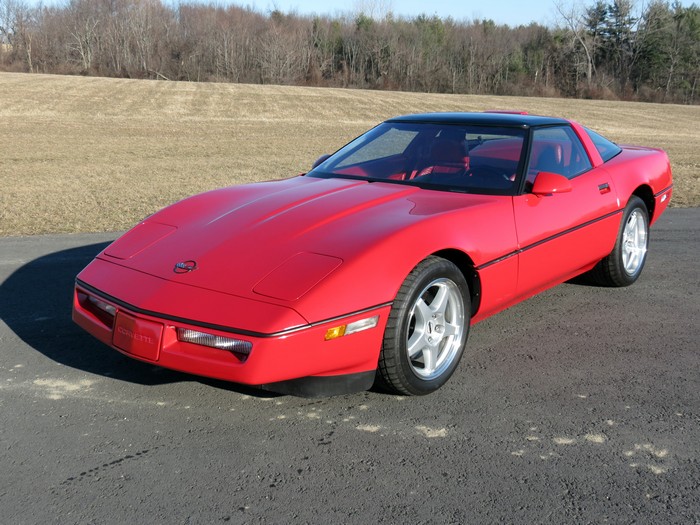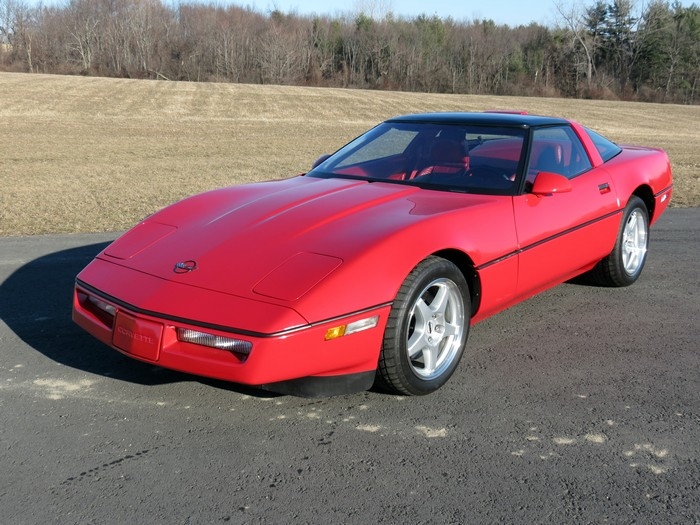
This 1990 Corvette ZR-1 was once part of Mike Yager’s personal collection.
All original documentation comes with the car, including the original welcome letter from GM and a complete vehicle history in a scrapbook that includes all documents, photos and other memorabilia.
SCM Analysis
Detailing
| Vehicle: | 1990 Chevrolet Corvette ZR-1 |
| Years Produced: | 1990–95 |
| Number Produced: | 3,049 in 1990, 6,939 total |
| Original List Price: | $60,000–$67,000 |
| SCM Valuation: | $21,500–$31,500 |
| Tune Up Cost: | $500 |
| Distributor Caps: | $28.00 |
| Chassis Number Location: | On windshield VIN tag, block and chassis |
| Engine Number Location: | On engine pad |
| Club Info: | National Corvette Restorers Society (NCRS) |
| Website: | www.ncrs.org |
| Alternatives: | 1990–2005 Acura NSX, 1987–91 Corvette B2K Callaway Twin Turbo, 1992 Dodge Viper RT/10 roadster |
| Investment Grade: | C |
This ex-Mike Yager 1990 red/red ZR-1, Lot 390, sold for $23,100, including buyer’s premium, at Barrett-Jackson’s Palm Beach auction in Palm Beach, FL, on April 4–6, 2013. For those of you who don’t know Mike, he’s the founder of Mid America Motorworks — one of the country’s largest Corvette parts and accessories suppliers, and a well-known Corvette collector.
Corvette performance reborn
The mid-1970s weren’t kind to Corvette. Federal emissions and fuel economy standards choked performance significantly — horsepower and torque more or less vaporized, culminating in an all-time low 165-hp rating for the base 350 V8 in 1975.
That was also the year Dave McLellan took over as Corvette’s chief engineer. He had a tough act to follow in Zora Arkus-Duntov, as well as a rough road ahead thanks to the general climate of the industry at the time. But he understood the need to revitalize the brand, and the C4, produced as a 1984 model, was his team’s first stab at doing just that.
But McLellan wasn’t content to leave well enough alone — several enhanced-performance Corvettes were needed to really boost the car’s image back to its former glory. The first project was the twin-turbo B2K option, produced by Callaway Engineering in Old Lyme, CT. 512 cars were factory ordered in this program from 1987 to 1991. The second project was the ZR-1. A total of 6,939 of these high-tech, high-performance Corvettes were produced from 1990 through 1995.
Building a better peformance ’Vette
On the outside, the ZR-1 has an understated look that is visually very similar to the standard C4. But the ZR-1 was a completely different animal, starting under the hood with the Lotus-engineered and Mercury Marine-built LT5 engine.
The stock L-98 C4 Corvette engine and the ZR-1’s LT5 shared a 350/5.7L displacement, but that was their only similarity. ZR-1 motors had all-aluminum blocks, Nikasil wet liners, 32 valves, four overhead cams, and a valet key-activated advanced engine management system. That system controlled a solenoid-actuated variable intake system that closed off half of the 16 intake runners and disabled half of the engine’s 16 fuel injectors when the engine ran at less than full throttle.
The driver could toggle the system on and off. That meant you could restrain it to about 250 hp for the dealership oil-change guy or parking attendant, or leave it on for a stout 375 hp — a big deal in the performance climate of 1990. LT5 power inched its way to 405 by 1993, and it could be timed, tuned and mapped to over 600 hp. The motors were all hand-built and individually dyno tested in Stillwater, OK, at the Mercury Marine Plant.
Other ZR-1 components included an on-the-fly driver-controllable active suspension system by Bilstein, redesigned rear body work that was three inches wider than the standard C4, huge 315/35ZR-17 rear tires, a full-synchro 6-speed ZF transmission, upgraded 11.5-inch HD brakes, and special steering. Even the wheel bearings were upgraded from what was used on the standard C4.
The windshield was bronze-tinted to reduce cockpit heat, and there was a strategically placed clear section at the bottom that gave radar detectors a clean view ahead. Last I heard, an OEM replacement windshield was $1,800 — and they were discontinued in January 2003.
The ZR-1s were all about performance, and they delivered, with 0–60 times of about 4.5 seconds off the showroom floor. In fact, in March of 1990, a completely stock ZR-1 set a world record for speed and endurance, managing a 175 mph average for 24 hours, completing 4,221 miles without any material issues. So despite its complexity, the ZR-1 was extremely reliable — and it still met all government standards for safety and emissions, and avoided the EPA’s Gas Guzzler tax.
But buyers paid for all those pluses, with a base price double that of the standard 1990 Corvette.
This car
Mike Yager was the second owner of this low-mile, first-year ZR-1. Of course it had all the right paperwork, books, letters and documentation. This was one of 18 cars Mike sold at an RM auction a few years ago to upgrade his startling collection of engineering, styling and race Corvettes. In fact, Mike says that in order to buy the next four Corvettes for his collection, the net proceeds from the sale of the 18 were still “short.”
Overall, our subject car is in good shape, as many of these cars are. A lot of these cars were set aside by enterprising owners as instant collectibles — cars to be sold in the future for a profit. But since a lot of guys did that, there was always a good supply of in-the-wrapper examples out there, and prices never took off — especially as base-level Corvette performance caught up and surpassed ZR-1 levels.
And adding to their complexity, ultra-low mile ZR-1s tend to have issues relating to their age — gas goes bad and fuel systems need to be cleaned or rebuilt, seals dry up, and rubber components expire. Parts for these cars are expensive, so bringing one back to life can be costly, depending on what it needs.
With a ZR-1, a decent number of miles on the clock can prove to be a good thing — especially if they’re documented as having been added over time. This car had approximately 20k miles on the clock, so it was used enough to limit mechanical atrophy. A quick Web search showed this car as having 11,225 miles when it was offered for private sale in May of 2003, so it appears that its use was more or less constant over the years, if light. That’s what I’d be looking for in one.
A lot of Corvette for the money
Lot 390 sold for $23,100, which is right on the current market level for these cars in this condition. The Yager connection is a nice plus, but I don’t think it added significant value to the bottom line here.
There are dozens of these low-mile examples on the market at any one time, and I think they’re among the best values for money in the Corvette world today. The ZR-1 may not be the fastest late-model Corvette anymore, but its performance is still staggering, and I think one should be part of any collection of low-production, high-performance vehicles.
I have had both a ’90 and ’95 in my garage, and I’ve driven them hundreds of miles. For price, performance, and fun factor, this ZR-1 was a great deal. Just remember to always keep that valet key in the “on” position.
(Introductory description courtesy of Barrett-Jackson.)
